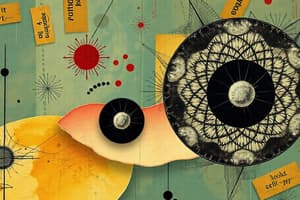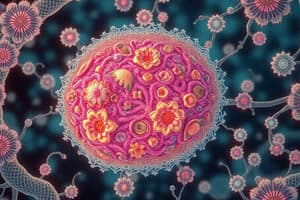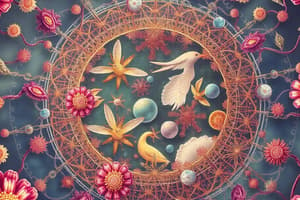Podcast
Questions and Answers
What is the function of the Nucleus?
What is the function of the Nucleus?
- To produce proteins
- To transport molecules
- To store energy
- To contain the DNA of a eukaryotic cell (correct)
Which of the following are contents of the nucleus? (Select all that apply)
Which of the following are contents of the nucleus? (Select all that apply)
- Chromatin (correct)
- Ribosomes (correct)
- Nucleoplasm (correct)
- Cell membrane
What is nucleoplasm?
What is nucleoplasm?
A type of protoplasm found in the nucleus of Eukaryotic cells.
What is the function of nucleoplasm?
What is the function of nucleoplasm?
What is the nuclear envelope?
What is the nuclear envelope?
What is the nuclear matrix?
What is the nuclear matrix?
What is the primary function of the nucleolus?
What is the primary function of the nucleolus?
What are ribosomes?
What are ribosomes?
What is chromatin?
What is chromatin?
What is the function of chromatin?
What is the function of chromatin?
What are chromosomes?
What are chromosomes?
What is the function of chromosomes?
What is the function of chromosomes?
What is the difference between chromatin and chromosomes?
What is the difference between chromatin and chromosomes?
Flashcards are hidden until you start studying
Study Notes
Nucleus
- Prominent round structure in eukaryotic cells, housing the cell's DNA.
- Contains essential components like nucleoplasm, nuclear envelope, nuclear matrix, nucleolus, ribosomes, chromatin, and chromosomes.
Nucleus Contents
- Composed of nucleoplasm, nuclear envelope, nuclear matrix, nucleolus, ribosomes, chromatin, and chromosomes.
Nucleoplasm
- Found only in eukaryotic cells, serving as the intracellular fluid within the nucleus.
- Composed mainly of water, along with various dissolved molecules and ions.
- Enclosed by the nuclear membrane; provides a suspension medium for nuclear organelles.
Nucleoplasm Function
- Acts as a medium for suspending organelles and maintains nuclear structure and shape.
- Facilitates the transport of ions and molecules vital for cell metabolism and functioning.
Nuclear Envelope
- Double membrane surrounding the nucleus with multiple pores regulating macromolecule passage.
- Permits free movement of water, ions, ATP, and small molecules while controlling larger macromolecules like proteins and RNA.
Nuclear Matrix
- Network of fibers inside the nucleus, providing structural support, analogous to the cytoskeleton in the cell.
Nucleolus
- Largest structure in the nucleus, comprising proteins and ribonucleic acids (RNA).
- Primary function is the assembly of ribosomes, taking up about 25% of the nucleus' volume.
- Organizes regions of chromosomes containing genes for pre-rRNA, essential for ribosome formation.
Ribosomes
- Organelles formed in the nucleolus, serving as the site of protein synthesis in the cytoplasm.
- Composed of ribosomal RNA (rRNA) and proteins, structured into two subunits.
Chromatin
- DNA double helix packaged with special proteins (histones) forming a complex that facilitates compact storage.
- Further condenses to form chromosomes, enabling DNA protection and regulation.
Chromatin Function
- Packages DNA into a smaller volume for cellular accommodation.
- Controls gene expression and DNA replication; strengthens DNA during mitosis and meiosis, preventing damage.
Chromosomes
- Compact structures consisting of nucleic acids and proteins, found in the nucleus of living cells.
- Carry genetic information in the form of genes and are made from chromatin.
Chromosome Function
- Contain genetic instructions, contributing to unique traits in offspring, with one chromosome inherited from each parent.
Chromatin and Chromosome Differences
- Chromatin is the relaxed form of DNA, while chromosomes are the condensed, tightly packed structures that are visible during cell division.
Studying That Suits You
Use AI to generate personalized quizzes and flashcards to suit your learning preferences.




